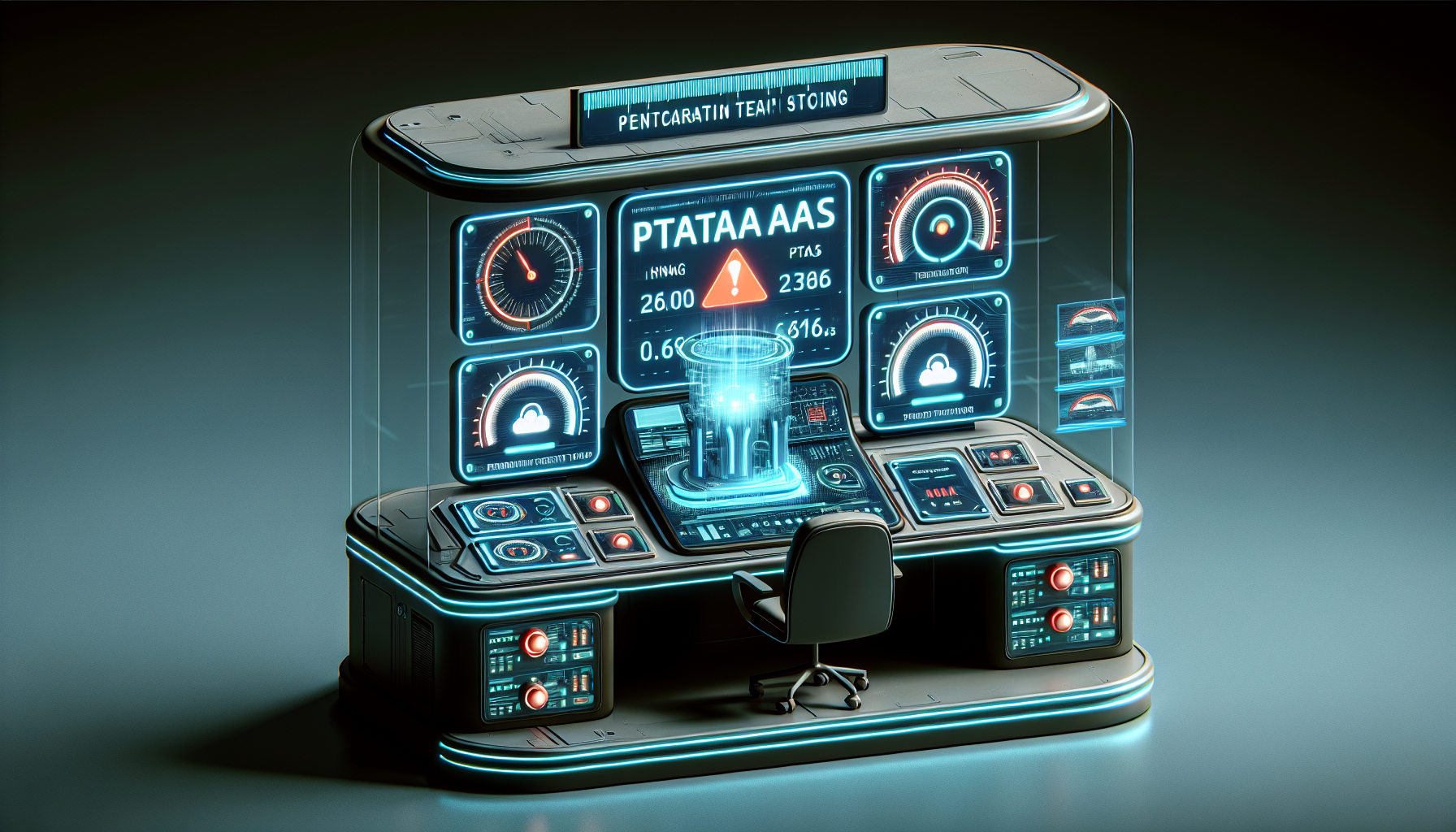Simply put,penetration testing as a service or PTaaS is a continuous guard against cyber threats, offering an ongoing cycle of testing that traditional penetration tests don’t provide. This service combines the insights of security experts with the efficiency of automated scanning to help businesses stay ahead of security breaches. We’ll unpack PTaaS in this article, clarifying its role and advantages in a digestible format for businesses navigating the complexities of cybersecurity.
Key Takeaways
-
PTaaS offers continuous, on-demand penetration testing services. It employs both automated tools and human expertise to detect vulnerabilities and protect against evolving cyber threats.
-
PTaaS incorporates a range check types, including network-level, application, and system-wide assessments, ensuring comprehensive security coverage tailored to an organization’s unique digital landscape.
-
The integration of PTaaS into business processes, especially within DevSecOps, enhances cybersecurity at every stage of the software development lifecycle and aligns pentesting with business objectives and strategies.
Decoding Penetration Testing as a Service (PTaaS)
Penetration testing, the art of simulating cyber-attacks to find weaknesses before the bad guys do, has evolved. The traditional approach of periodic ‘traditional pentests’ is now outshone by the continuous and dynamic nature of PTaaS. Imagine having a team of cyber experts and automated systems constantly patrolling your network, ready to adapt to new threats at a moment’s notice.
This encapsulates PTaaS, a service model that guarantees your defenses remain adaptable to ever-changing threats.
The PTaaS Model Unveiled
In the cybersecurity realm, timing holds pivotal importance. PTaaS, ever ready, steps up as an on-demand champion, prepared to face danger whenever it surfaces. This strategic flexibility allows businesses to schedule security assessments at their convenience, scaling up or down as needed, without being shackled to traditional testing timelines.
When trying to solve a problem, it’s essential to identify the root cause to find the most effective solution. By doing so, you can save time and resources while addressing the issue at its core, covering more ground in the process.
Human Expertise Meets Automation
PTaaS combines the brilliance of human intelligence with the unwavering efficiency of automation. This alliance ensures that even the most cunning vulnerabilities cannot slip through the net. Automated scanning, continuously vigilant, is complemented by the discerning eye of human experts, who delve into the complexities where machines tread lightly.
Service Delivery and Access
Think of the ability to launch a penetration test instantly with a click, starting a security assessment in just 24 hours. PTaaS breaks the chains of delay, offering rapid automated tests that unfold within hours and comprehensive manual tests that wrap up within a workweek. It’s the equivalent of having a rapid response team at your beck and call, ensuring your digital fortress remains impregnable.
Identifying the Role of Security Engineers in PTaaS
At the core of every PTaaS operation resides the security engineer, a watchman whose expertise forms the foundation of your cyber defense. With certifications like OSCP, CEH, and CISSP, these engineers are the elite force tasked with the crucial mission of identifying the most elusive of vulnerabilities. They are the architects of your security, shaping the defenses to protect your digital realm from the most sophisticated of cyber threats.
From Assessment to Action
The journey from vulnerability assessment to the fortification of defenses is a meticulous one, orchestrated by the strategic minds of security engineers. Their crafted plans and scripts are tailored to the unique landscape of each client, simulating real-world attack vectors that reveal the true mettle of your current security posture and cyber defenses against potential threat actors. By examining vulnerability details, they can identify and address weak points in your security.
Verifying and Reporting Findings
Once the battle is over, the security engineers lay out the map of the battlefield, detailing each exploit and vulnerability with precision. These reports are not mere documents but guiding stars that prioritize the path to remediation. They serve as a bridge between the technical trenches and the strategic summits of management and stakeholders, ensuring that no detail is lost in translation.
Benefits of Adopting PTaaS Over Traditional Penetration Testing
Adopting PTaaS is akin to switching from a semaphore to a high-speed internet connection for your cybersecurity approach. It’s a leap from infrequent, static testing to a continuous, integrated security approach that keeps pace with rapid development cycles.
Real-time vulnerability detection, flexible and scalable service models, and the ability to support DevSecOps – PTaaS is the modern-day guardian of the digital realm.
Why Businesses Choose PTaaS
What makes businesses gravitate towards PTaaS? The answer is multifaceted:
-
Cost efficiencies bloom when time-consuming processes are automated.
-
The drumbeat of frequent testing uncovers a wider array of weaknesses.
-
A proactive security culture becomes ingrained within the organization.
Furthermore, the intelligence from PTaaS helps prioritize pentesting efforts, ensuring that the most vulnerable assets receive the attention they need.
Real-Time Reporting and Remediation
The true prowess of PTaaS shines in its real-time reporting capabilities. Like a vigilant watchtower, it offers immediate insights into vulnerabilities, granting businesses the power to:
-
Respond with swiftness and precision
-
Reduce the window of exposure to potential threats
-
Benefit from a blend of machine-driven speed and human-directed insight
The Ideal PTaaS Vendor: Features to Look For
When searching for the perfect PTaaS vendor, it’s essential to find a balanced combination of thorough testing, clear pricing, and a unified platform that brings together various cybersecurity tools. Such a platform ensures that no stone is left unturned, from quarterly tests that reveal the unseen to adherence to stringent compliance standards.
Your chosen vendor should be a beacon of clarity and efficiency in a sea of digital threats.
Comprehensive Coverage and Depth
The realm of cyber threats is vast, and so the coverage of your PTaaS provider must be equally expansive. They must chart the depths of your digital landscape, ensuring that every crevice and corner is scrutinized for vulnerabilities. This includes the seamless integration with enterprise systems, ensuring that the results of the penetration tests enhance the operational workflow rather than hinder it.
Actionable Insights and Support
The aftermath of a penetration test should not leave you adrift in a sea of technical jargon. The ideal PTaaS vendor extends a helping hand, offering post-test support and insights that translate findings into actionable steps. Their reports should serve as a lighthouse, guiding every level of your organization from the stormy waters of vulnerabilities to the safe harbor of cybersecurity.
Penetration Tests Types Within the PTaaS Framework
Within the PTaaS framework, a range of penetration tests are tailored to the diverse terrains of digital assets. From the comprehensive to the agile, these tests span across networks, applications, and APIs, employing methodologies like Black Box, Grey Box, and White Box to uncover every potential threat.
PTaaS ensures that whether for compliance or security, no vulnerability remains hidden.
Network-Level Scrutiny
In the domain of network-level scrutiny, PTaaS stands as the guardian of the gates, probing the ramparts of your IT infrastructure. Security engineers map out the terrain, deploying simulations of real-time attacks to test the resilience of your network’s defenses. This scrutiny is not just a check; it’s a full-scale siege test, ensuring that the walls of your digital fortress can withstand the onslaught of cyber threats.
Application Deep Dive
Plunging into the depths of your applications, PTaaS seeks out the weaknesses within web and mobile ptaas platforms. By deploying both automated tools and the nuanced understanding of security professionals, PTaaS reveals the chinks in the application armor, ensuring that no breach goes undetected.
It’s a relentless quest to secure the very software that powers your digital presence.
System-Wide Assessments
Beyond individual components, PTaaS offers system-wide assessments, an expansive survey of your entire cybersecurity landscape. This holistic approach ensures that threats, no matter how dispersed or hidden, are brought into the light. The comprehensive nature of these assessments means that security engineers must be adept at navigating the complexities of various systems, from networks to APIs, leaving no stone unturned.
PTaaS Integration in Business Processes
Integrating PTaaS with business operations offers several benefits:
-
It incorporates a protective layer into the organization’s structure, keeping security top of mind.
-
It dynamically adjusts testing methodologies to meet the ever-changing threat landscape.
-
It fortifies trust among stakeholders.
-
It ensures that pentesting efforts are finely tuned to the business’s evolving digital assets.
Embedding PTaaS in DevSecOps
The marriage of PTaaS and DevSecOps is a match made in cybersecurity heaven. Here, security testing becomes a continuous thread woven through the software development lifecycle, ensuring that each code change is scrutinized for weaknesses. As the digital threat landscape morphs, so too must the strategies employed within DevSecOps, with PTaaS providing the insights necessary to adapt and refine.
Aligning with Business Objectives
Tailoring the PTaaS approach to the unique objectives of a business is essential for alignment with the broader security mission. By focusing on areas of greatest concern, PTaaS becomes not just a tool but a strategic ally, advising on risk mitigation and vulnerability repair.
This tailored approach ensures that pentesting efforts are not only effective but resonate with the company’s goals and values.
Machine Learning's Role in Enhancing PTaaS
Integrating machine learning with PTaaS offers several benefits:
-
It enhances the platform’s capabilities, allowing for more sophisticated threat detection.
-
It provides a predictive stance in managing vulnerabilities.
-
Machine learning’s algorithms prioritize vulnerabilities, helping security teams focus their efforts where they are needed most.
Advanced Threat Detection
Machine learning algorithms are the watchful eyes that never sleep, constantly analyzing patterns to predict and detect threats before they manifest. These cognitive abilities, coupled with the detailed information from attack surface management, empower PTaaS to craft tailored attack scenarios, elevating the relevance and effectiveness of penetration tests.
Predictive Vulnerability Management
Predictive vulnerability management is the art of foreseeing the storm before the clouds gather. Machine learning algorithms sift through the sands of data to forecast the severity of vulnerabilities, prioritizing them for remediation. This prophetic approach allows businesses to plan their defense strategies intelligently, ensuring that their digital fortresses are reinforced against the most likely threats.
Summary
As we come to the end of our exploration of Penetration Testing as a Service, it’s clear that PTaaS stands as a beacon of modern cybersecurity. From the seamless integration with business processes to the predictive prowess of machine learning, PTaaS empowers organizations to stay ahead of cyber threats. It’s not just about finding vulnerabilities; it’s about creating a proactive, adaptive, and robust defense that keeps pace with the ever-evolving digital landscape.
Frequently Asked Questions
What distinguishes PTaaS from traditional penetration testing?
PTaaS distinguishes itself from traditional penetration testing by providing continuous, dynamic security assessments with real-time reporting and remediation, and by supporting agile development processes like DevSecOps. This makes it more efficient compared to periodic testing.
How important is human expertise in PTaaS?
Human expertise is crucial in PTaaS for uncovering sophisticated vulnerabilities, validating automated findings, and maintaining proactive security culture within an organization. Therefore, it plays a vital role in ensuring comprehensive protection against evolving threats.
What features should I look for in an ideal PTaaS vendor?
Look for comprehensive coverage, transparent pricing, a unified platform, and actionable insights for efficient security management when choosing a PTaaS vendor. These features will ensure effective protection for your organization.
Can PTaaS integrate with my business's existing processes?
Yes, PTaaS is designed to seamlessly integrate with business processes, dynamically updating testing methodologies and aligning with business objectives and security strategies. With PTaaS, you can streamline your existing processes and enhance security.
How does machine learning enhance PTaaS?
Machine learning enhances PTaaS by improving threat detection, predictive vulnerability management, and prioritizing vulnerabilities for remediation, leading to increased efficiency and effectiveness in penetration tests.






Comments